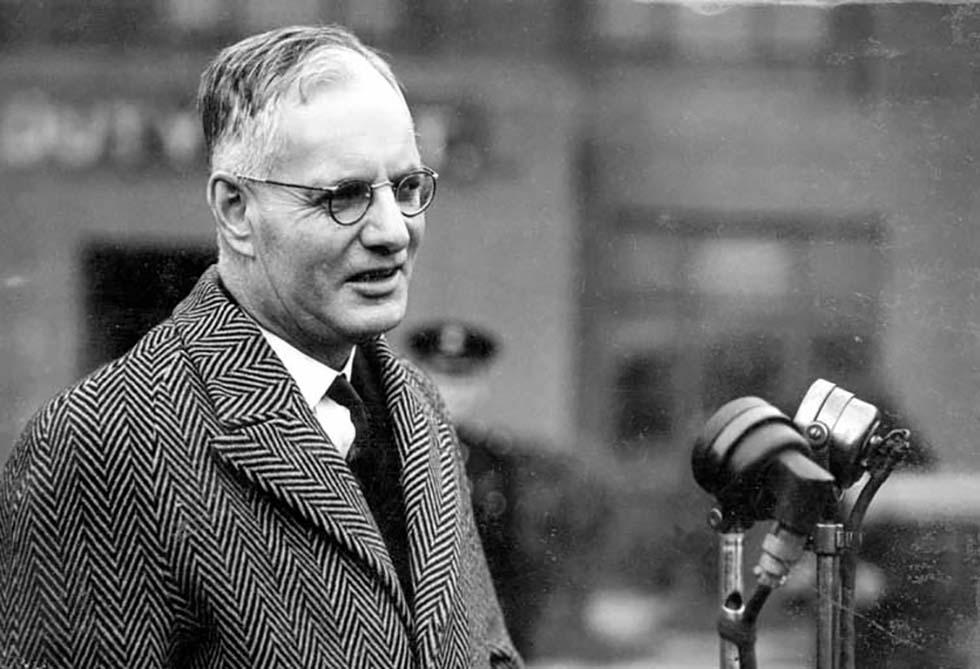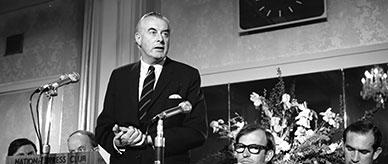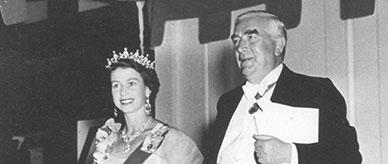


About this record
This is a photograph of Prime Minister John Curtin, probably speaking to the press, on his arrival in England by air for the first meeting of the Imperial Conference of Empire Prime Ministers on 1 May 1944. John Curtin, wearing a herringbone tweed overcoat, is shown standing in front of two microphones and a policeman stands in the background.
Educational value
- Shows Australia's wartime Prime Minister, John Curtin, following his arrival in London on 29 April 1944 for the Imperial Conference of Empire Prime Ministers opening on 1 May 1944 – other prime ministers attending the conference included Winston Churchill (United Kingdom), Peter Fraser (New Zealand), WL Mackenzie King (Canada) and Field-Marshall J C Smuts (South Africa); the Imperial Conference of Prime Ministers evolved into the Commonwealth Heads of Government Meeting, following the achievement of independent nationhood by former British colonies in the decades after the Second World War.
- Shows Curtin arriving in England from Australia following a journey of several weeks during wartime – Curtin was accompanied by his wife Elsie and a party of 16 military and diplomatic officials, including Secretary for Defence Sir Frederick Shedden and Commander-in-Chief of Australian Military Forces Sir Thomas Blamey; the party had travelled on the ship 'Lurline' across the Pacific to San Francisco, by rail across the USA to New York and Washington, where Curtin conferred with US President Franklin D Roosevelt, and then by air across the Atlantic to London.
- Depicts Prime Minister Curtin speaking on issues of importance to Australia in the later stages of World War II – Curtin raised three significant issues at the Imperial Conference: Australia's access to information from, and input into, decision-making by the British War Cabinet in matters concerning the conduct of the war; improved processes and procedures for cooperation between leaders of the British Empire and Dominions; and the importance of postwar cooperation in Empire defence, particularly in the Asia–Pacific region.
- Shows Australia's 14th Prime Minister (1941–45) – Curtin led the Labor government during World War II, serving also as Chair of the Advisory War Council, member of the War Cabinet, Minister for Defence Coordination, Minister for Defence and, several times, acting Minister for External Affairs; Curtin died in office on 5 July 1945, shortly before the end of the war in the Pacific and the defeat of Japan.
- Portrays the architect of Australia's 'turn to America' in England – in 1942 Curtin had rejected the British strategy that Australian troops stay in the Middle East and had insisted on focusing Australia's War effort on the Pacific in cooperation with US forces.
- Shows John Curtin about a year before the end of his career as Prime Minister and the end of his life – born in Victoria, Curtin moved to Perth, Western Australia, in 1917 to become editor of the Westralian Worker newspaper; he was an activist within the labour movement and an outspoken opponent of conscription in 1916–17; Curtin won the federal seat of Fremantle in 1928, serving in the Scullin Labor government; he lost the seat in 1931 but regained it in 1934, holding it for the remainder of his career; Curtin succeeded Scullin as party leader in 1935, leading the Opposition until he became Prime Minister in October 1941.
Acknowledgments
Learning resource text © Education Services Australia Limited and the National Archives of Australia 2010.
Related themes
Need help with your research?
Learn how to interpret primary sources, use our collection and more.



